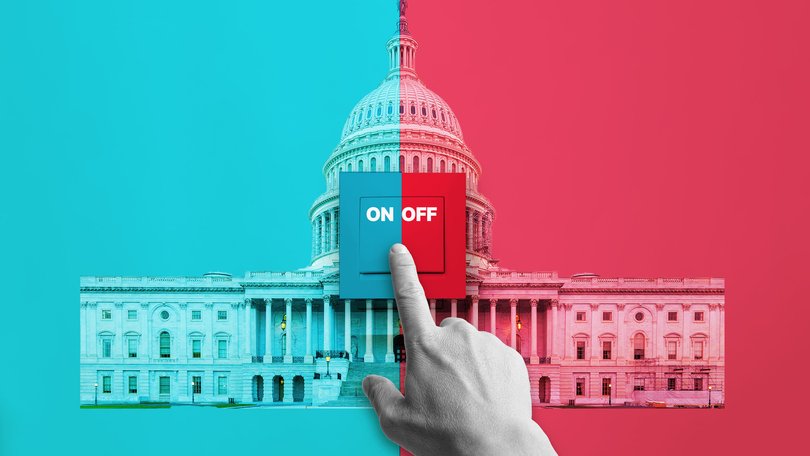THE ECONOMIST: The US Government shutdown and what it means for America’s economy

With hours to go before a possible government shutdown, Democrats and Republicans are right back where they started: blaming the other side for their intransigence. A White House meeting between the President and Chuck Schumer and Hakeem Jeffries, the top Democrats in Congress, failed to yield any compromise.
“We’re headed to a shutdown because the Democrats won’t do the right thing,” lamented J.D. Vance, the Vice-President. “There are still large differences between us,” retorted Mr Schumer.
Federal agencies will start to run out of money at 12.01am, local time, on Wednesday (2pm AEST). Some of the most visible effects will include the closure of agencies, national parks and museums. Federal workers will have their pay frozen, including those who have to stay on the job, like the armed forces or air-traffic controllers.
Sign up to The Nightly's newsletters.
Get the first look at the digital newspaper, curated daily stories and breaking headlines delivered to your inbox.
By continuing you agree to our Terms and Privacy Policy.Social Security and Medicare payments, which are considered “mandatory” spending, will keep going, although cheques could be delayed.
It is easy to think that this particular failure of governance is happening more often. Yet far fewer shutdowns have taken place in the past two decades than in the 1980s and 1990s. And though recent shutdowns have tended to last longer — such as the record 35-day shutdown in 2018-2019 during Donald Trump’s first term — their economic impact seems to have been limited.
That may well be the case this time, but there are a few wrinkles in today’s American economy that complicate things. A shutdown would probably mean that important economic statistics, most notably employment figures from the Bureau of Labour Statistics (BLS), which are due out on October 3, are delayed.
The BLS also produces data on inflation and wages, which are closely scrutinised. At a time when the outlook for the American economy overall is murky and the Federal Reserve’s interest-rate decisions have been unusually contentious, leaving policymakers to grope in the dark is hardly ideal.
Financial markets, for their part, tend to treat shutdowns mostly as non-events beneath the noisy politics. During the last shutdown, for example, the S&P 500 bottomed out on the third day and ended up 10 per cent higher than where it started.
But looking across the past few decades’ shutdowns, Goldman Sachs, a bank, does find that the dollar has typically declined following the start of a shutdown. From the tariffs of “Liberation Day” to attacks on the Federal Reserve, the administration has already done plenty this year to ding the dollar. A shutdown would be an unwelcome addition but not more than that.
Furloughing 900,000 non-essential federal employees, or about 40 per cent of the workforce, would also push unemployment up and growth down in the short term. The government payroll was already expected to shed 300,000 workers by December, mostly as a result of deferred resignation packages offered by the Department of Government Efficiency (DOGE) earlier in the year.
The Congressional Budget Office estimates that the shutdown in 2018-19 knocked 0.02 per cent off GDP that year, due to the loss of furloughed workers’ contribution to the economy and delays to federal spending.
People looking for a new job would also be hit with a tricky hiring environment: job growth has slowed sharply in recent months, especially in the areas around Washington, DC such as Virginia and Maryland, where many federal workers and contractors live.
Usually, those effects are swiftly reversed when a shutdown ends, as employees return to work with their pockets stuffed with back pay. That might not be the case this time.
Russell Vought, the director of the Office of Management and Budget (OMB), has encouraged the Federal Government to use a shutdown as an opportunity to fire thousands of federal workers and gut government programmes should funding lapse. His office circulated a memo urging the heads of departments to consider getting rid of all employees working on parts of the budget covered by discretionary spending and which do not align with the President’s priorities.
That might be dismissed as a tactic to put pressure on Democratic senators to vote for a budget, except that it aligns both with Mr Vought’s long-held goals and a widely shared antipathy to the federal bureaucracy in the Republican Party.
No statute explicitly provides agencies with the power to fire workers due to a lapse in appropriations. And in practice, a shutdown means HR departments inside most federal agencies would also go unfunded, precluding them from following the proper procedures required to dismiss laid-off workers.
Yet questions over legality or process are unlikely to stop the administration, argues Bobby Kogan, a former OMB official now of the Centre for American Progress, a left-of-centre think-tank. “It seems like they’ve been wanting to do this for a long time,” he adds.
One lesson from the DOGE experiment was that the administration can move much faster than the courts. By the time the judges decide that an institution should not have been gutted, it is already beyond repair.
